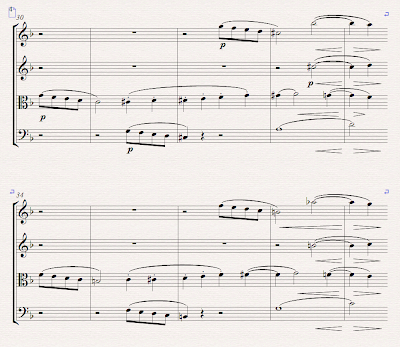These eight measures are essentially a repetition of the previous eight measures with a different accompaniment. But the repetition is not exact. Beethoven alters the melody of the second phrase. If the repetition were exact, the second phrase would be as follows:
Why does Beethoven change the melody? To maintain good two-part counterpoint. The second highlighted note in the unaltered version is an E. In the soprano, we have an F (an appoggiatura) resolving to E. When a dissonance resolves to a note that is already present in another voice, it is called "anticipating the resolution." This is OK in two-part texture when the resolution is to the tonic or to the fourth or fifth degree of the scale (as it is in phrase A) but not when the resolution is to the third degree of the scale. Our modern-day ears aren't so sensitive to such niceties, since they are used to hearing much worse. But, to Beethoven, the above passage would sound noticeably weak. So he changes the melody to avoid the problem.
That means the melody reaches its goal, F-sharp, one beat early, so he ties the F-sharp to the downbeat of the next measure. This problem does not occur in phrase A, so Beethoven leaves that phrase unaltered.
Why am I going into all this? Because Beethoven does something interesting in his string arrangement. He decides to alter both phrases:
As you can see, he changes the melody of phrase A to match phrase B. In addition, he changes the first C-sharp in the right hand to a C-natural, which works better with the altered melody.
I can't imagine there is anything specific to string writing that prompted the decision to alter phrase A. I think Beethoven just decided he liked the theme better this way, and rightly so. Changing only the second phrase makes it appear that the change is one of necessity. Changing both phrases makes it appear voluntary, as if variety were the sole consideration. It's the musical equivalent of putting the awkward rhyme first in a rhymed couplet so as not to draw attention to it. Bach, whom Beethoven consciously emulated, did this sort of thing frequently.
Back to Beethoven's scoring decisions. Here is the literal transcription:
And here is Beethoven's arrangement:
It surprises me that Beethoven chooses to give the melody to the second violin rather than to the viola, not so much because it requires crossing parts in measures 33 and 37 but because we just heard this melody played by the first violin. So I would have expected Beethoven to give this utterance to the viola for a change of color.
As he has done previously in this movement, Beethoven replaces the half notes in the cello at the end of each phrase with staccato quarter notes, giving the downbeats an extra fillip.
Finally, Beethoven has the viola double the first violin's entrance in measures 32 and 36 a tenth below. Simply having the viola jump in at the last minute to assist with the chords at the end of the phrase would sound a bit abrupt. This change makes for a smoother transition into the cadence. The quarter-note rests are, of course, necessitated by the fact that the violist must skip over a string to reach the high notes.





No comments:
Post a Comment